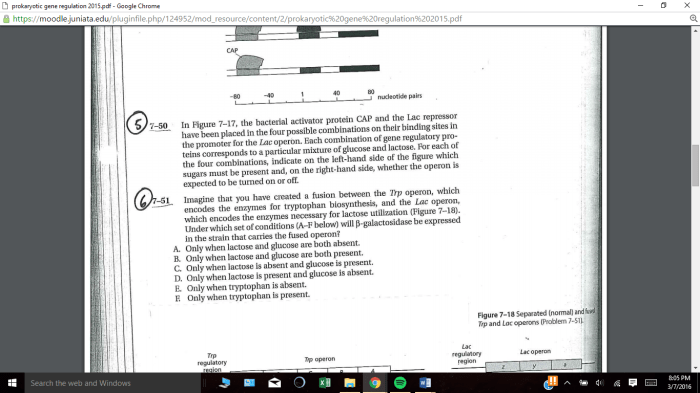Control of gene expression in prokaryotes pogil answers pdf – Unveiling the intricate mechanisms of control of gene expression in prokaryotes, this comprehensive guide embarks on an academic exploration of the molecular underpinnings that govern gene regulation in these ubiquitous microorganisms.
Delving into the realms of transcriptional, translational, and post-translational regulation, this discourse elucidates the fundamental principles and molecular players involved in controlling gene expression in prokaryotes, providing a solid foundation for understanding the intricate interplay between genetic information and cellular processes.
1. Transcriptional Regulation in Prokaryotes

Transcription is the process by which the information encoded in DNA is copied into RNA. In prokaryotes, transcription is regulated by a variety of factors, including sigma factors, promoters, activators, and repressors.
Sigma factors are proteins that bind to RNA polymerase and help it to recognize and bind to the promoter region of a gene. The promoter region is a specific sequence of DNA that signals the start of a gene. Once RNA polymerase is bound to the promoter region, it can begin to transcribe the gene into RNA.
Activators are proteins that bind to DNA and help to promote transcription. Repressors are proteins that bind to DNA and help to prevent transcription.
Examples of transcriptional regulation in prokaryotes:
- The lac operon is a group of genes that are involved in the metabolism of lactose. The lac operon is regulated by a repressor protein. When lactose is present in the cell, the repressor protein is bound to the lac operon and prevents transcription.
When lactose is not present, the repressor protein is not bound to the lac operon and transcription can occur.
- The trp operon is a group of genes that are involved in the metabolism of tryptophan. The trp operon is regulated by a repressor protein and an attenuator. The repressor protein binds to the trp operon and prevents transcription when tryptophan is present in the cell.
The attenuator is a sequence of RNA that can form a hairpin loop. When tryptophan is present, the attenuator forms a hairpin loop and blocks transcription. When tryptophan is not present, the attenuator does not form a hairpin loop and transcription can occur.
2. Translational Regulation in Prokaryotes: Control Of Gene Expression In Prokaryotes Pogil Answers Pdf

Translation is the process by which the information encoded in RNA is used to synthesize proteins. In prokaryotes, translation is regulated by a variety of factors, including riboswitches, small RNAs, and post-translational modifications.
Riboswitches are sequences of RNA that can bind to specific metabolites. When a riboswitch binds to a metabolite, it can change the structure of the RNA and affect translation. For example, the trp attenuator is a riboswitch that binds to tryptophan.
When tryptophan is present, the trp attenuator forms a hairpin loop and blocks translation. When tryptophan is not present, the trp attenuator does not form a hairpin loop and translation can occur.
Small RNAs are non-coding RNAs that can bind to mRNA and affect translation. For example, the sRNA micF can bind to the mRNA of the ompF gene and prevent translation. The ompF gene encodes a porin protein that is involved in the transport of small molecules across the cell membrane.
When micF is present, the ompF gene is not translated and the cell is less permeable to small molecules.
Post-translational modifications are changes to proteins that occur after they have been synthesized. Post-translational modifications can affect the stability, activity, and localization of proteins.
Examples of translational regulation in prokaryotes:, Control of gene expression in prokaryotes pogil answers pdf
- The lac repressor protein is a post-translationally modified protein. When lactose is present in the cell, the lac repressor protein is phosphorylated. Phosphorylation changes the conformation of the lac repressor protein and prevents it from binding to DNA. When lactose is not present, the lac repressor protein is not phosphorylated and it can bind to DNA and prevent transcription.
- The trp attenuator is a post-translationally modified RNA. When tryptophan is present in the cell, the trp attenuator is cleaved by a ribozyme. Cleavage of the trp attenuator changes the structure of the RNA and allows translation to occur. When tryptophan is not present, the trp attenuator is not cleaved and translation is blocked.
Questions Often Asked
What is the role of sigma factors in transcription initiation?
Sigma factors are essential proteins that bind to RNA polymerase and direct it to specific promoter sequences, facilitating the initiation of transcription.
How do activators and repressors control transcription?
Activators bind to specific DNA sequences and enhance transcription by promoting the binding of RNA polymerase, while repressors bind to specific DNA sequences and inhibit transcription by blocking the binding of RNA polymerase.
What is the significance of riboswitches in gene expression?
Riboswitches are regulatory RNA elements that control gene expression by binding to specific metabolites or ligands, thereby modulating the translation of mRNA.
